STAY INFORMED
Must Watch Videos
Did Jesus die on Passover? Was Last Supper a Passover? Harmonizing Synoptics with John
Christians have noticed that Matthew, Mark, and Luke (MML) refer to the Last Supper as a “Passover” meal, but that John describes the temple Jewish Passover as happening 24 hours later. How are these two accounts harmonized?
The simplest solution is that the Last Supper was not the legal Passover meal of the Jews at which a slain lamb was roasted and eaten. The best harmonization of the four gospels requires that the Last Supper was a New Rite or a New Passover that superseded the Passover instituted by Moses and happened 24 hours before the legal Passover meal of the Jews.
I will prove that Christ kept the Last Supper 24 hours before the legal Passover of the Jews and that Christ died on the day of Nisan 14, the day of preparation for the Passover on which the lambs were slain. The Last Supper did not feature a dead animal lamb. Rather Christ’s presented Himself as teh edible Lamb at the Last Supper. The next day, Christ died at the same time as the passover lambs were slain. I will prove that this is the dominant position of the Church Fathers.
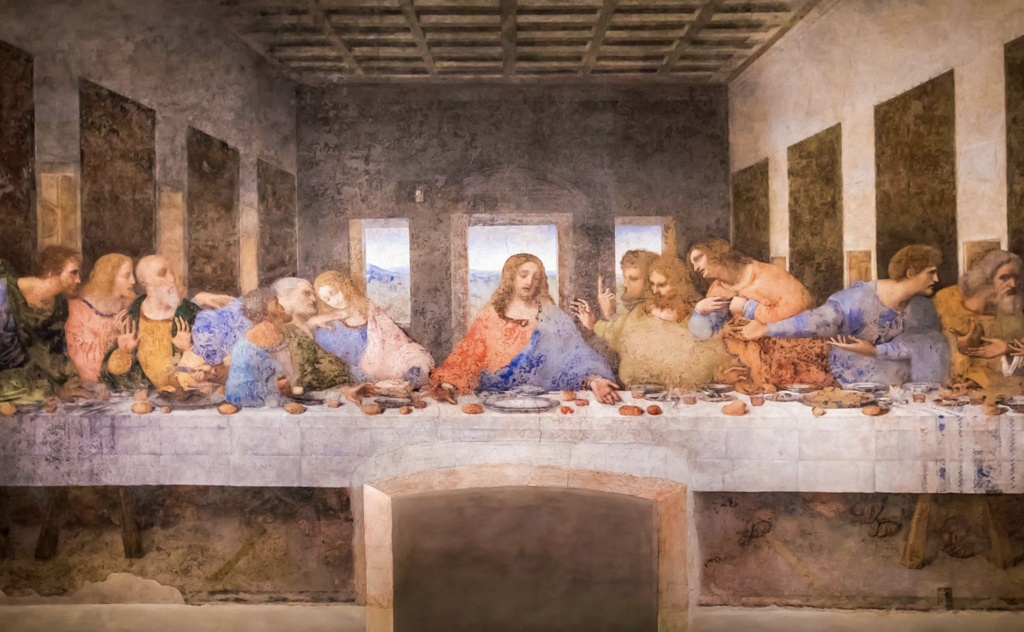
The Problem: Did Jesus die on Passover or the Day After Passover?
- In Matthew, Mark, and Luke (MML), Jesus claims to “eat this passover” (Luke 22:15) with His Apostles on the night before He died. Was that meal an actual Passover meal?
- The temple Jews, early on the next morning after the Last Supper, had not eaten the Passover: “Then they led Jesus from Caiaphas to the praetorium. It was early. They themselves did not enter the praetorium, so that they might not be defiled, but might eat the Passover.” (John 18:28) The temple Jews had not yet eaten Passover on the morning after the Last Supper, and were preparing to eat it later that night (which was after the death of Christ). Clearly, Jesus did not keep Passover at the same time as the temple Jews.
- Some say that Matthew, Mark, and Luke (MML) contradict John. MML place Christ’s Last Supper meal the night before Christ’s death. John places Jewish Passover on day that Christ died.
Possible Solutions:
- MML are correct and John was wrong or manipulated the story so that Jesus as “Lamb of God” died while the animal passover lambs were also killed at 3pm on Passover day.
- MML are wrong and John is correct.
- There is a way to harmonize the accounts. I will show the harmonization, because Sacred Scripture (and the four Gospels) cannot contradict one another.
How Passover Dates Work
Let’s understand how Moses set up the date structure for Passover:
- Jewish days begin at sundown (~6pm), not at midnight or at daybreak. All biblical calculations of time must account for this.
- “Nisan” is the Hebrew name of a month in Spring in which Passover feast occurs.
- The Jewish months were truly lunar, so the Nisan 1 is a new moon and Nisan 14 is a full moon.
- The Passover feast has two phases the pertains to two distinct days:
- Nisan 14: The passover lambs are slaughtered at the temple on the afternoon of Nisan 14 (3pm-5pm). They are then roasted and prepared to eat around 6pm at sundown.
- Nisan 15: After sundown (starting a new Jewish day with the initial hours of Nisan 15, the passover lambs are eaten by families as a liturgical rite. (Exodus 12:6)
The Passover Sequence of Jesus Christ and the Last Supper
- In the Synoptic MML, Jesus had his Last Supper on the evening before He was crucified. MML have Christ referring to this meal as a “Passover.”
- If the Last Supper was truly a Passover meal, then the passover lambs would have been killed on Nisan 14. This requires that Christ kept His Last Supper in the beginning hours of Nisan 15 and was crucified the next day on Nisan 15.
- However, if Jesus is the “Lamb of God,” then He should have died at the same time the other animal lambs were slaughtered on Nisan14, not on Nisan 15.
- John presents Nisan 14 as the day of His crucifixion and death and that the temple Jews had not yet eaten the Passover lambs.
Christian Controversy in Second Century
In the second century AD, a liturgical conflict emerged. Christians in Ephesus, Smyrna and Sardis celebrated Nisan 14 as the day of Christ’s death (not as “Easter” or “resurrection” as many sources falsely report), regardless of what day of the week Nisan 14 fell. This group was called the Quatrodecimans (from Latin quarta decima, meaning “fourteenth”).
The Quartodeciman Christians align almost perfectly with the seven churches mentioned in Revelation 2 and 3:
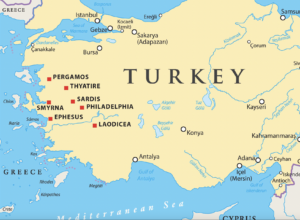 Ephesus
Ephesus
Smyrna
Pergamum
Thyatira
Sardis
Philadelphia
Laodicea
These seven churches were ruled by a bishop (called “an angel” in Revelation). They seem to have fallen under Saint John the Apostle who served as a Metropolitan Archbishop over the region. The regional popularity of Quartodeciman theology also maps onto the churches listed in the Apocalypse.
The Quatrodeciman Christians claimed their tradition came from Saint John the Apostle. This accurately conforms to John’s Gospel showing that Jesus died on Nisan 14 when the lamb’s were being slain.
Quartodeciman Theology and Praxis
Quatrodeciman Christians kept the custom of keeping Nisan 14 as a strict day of fasting from all food and then having a feast that night. Presumably a night Eucharist but in a manner similar to a Jewish Passover meal. Presumably, they observed the resurrection on Nisan 16, which would be the “third day.”
The Didascalia Apostolorum (c. 230 AD, Syria) describes the practice:
“On the fourteenth day of the moon… fast ye then also, and keep the Passover of the Lord, for on this day our Lord suffered… and on the evening of the fourteenth break your fast, and eat unleavened bread with Him who was sacrificed for us.” -Didascalia Apostolorum, Chapter 21
Saint Polycarp, Bishop of Smyrna, visited Rome around AD 155 to discuss the Paschal date with Pope Anicetus of Rome. Polycarp defended keeping Nisan 14, claiming it came from the Apostle John and other apostles. Though no direct ritual details are given, this establishes the practice’s apostolic origin and Polycarp’s adherence to keeping Nisan 14 as the day of Christ’s death.
“For Anicetus [bishop of Rome] could not persuade Polycarp to forgo the observance [of Nisan 14], inasmuch as these things had been always observed by John the disciple of our Lord, and by other apostles with whom he had been conversant… Polycarp himself was instructed by the apostles and conversed with many who had seen Christ.” – Eusebius, Ecclesiastical History 5.24.16-17 (quoting Irenaeus’ letter to Victor I)
And not just Polycarp. Writing c. AD 190 AD to resist Pope Victor’s push for Sunday Pascha, Polycrates asserts that Asia Minor’s bishops universally kept Nisan 14 as the day of Christ’s death, tying it to apostolic tradition (John, Philip) and martyrs (Polycarp).
“We therefore observe the genuine [fourteenth] day, neither adding thereto nor taking therefrom. For in Asia great lights have fallen asleep, which shall rise again on the day of the Lord’s appearing… Philip, one of the twelve apostles, who sleeps in Hierapolis… John, who rested upon the bosom of our Lord… Polycarp of Smyrna, both bishop and martyr… All these observed the fourteenth day of the Passover according to the gospel, deviating in no respect, but following the rule of faith.” – Eusebius, Ecclesiastical History 5.24.2-6 (Polycrates’ letter to Victor I)
In Rome and Alexandria, the churches kept the death and resurrection of the Lord always on a Friday and Sunday, respectively. In Rome and Alexandria, the Sunday after Nisan 14 was liturgically celebrated as the day of Christ’s resurrection and the Friday preceding (Good Friday) as the day of Christ’s death. The Roman and Alexandrian custom became standard way for all Christians to keep Pasch since at least the 4th century. The Roman and Alexandrian tradition sought to preserve the the resurrection as connected to Sunday, and by extension the death of Christ to Good Friday.
The important witness is that the Quadrodeciman Christians in the second century claimed that Saint John had taught them:
- Jesus died on Nisan 14
- That they should fast on Nisan 14 as the annual day of his death, regardless of what day of the week it fell upon.
This is a very strong witness that Jesus Christ died on Nisan 14 and not Nisan 15. This means we must show that the “passover” meal of Jesus at the Last Supper was not actually the legal passover of the temple Jews but something different.
Here’s how John conveys his timeline:
1. Timing of the Crucifixion: Preparation Day (John 19:14, 31)
John 19:14:
“Now it was the day of Preparation of the Passover; it was about the sixth hour. He [Pilate] said to the Jews, ‘Behold your King!'”
The “day of Preparation of the Passover” refers to Nisan 14, the day when Jews prepared for the Passover feast by slaughtering the lambs in the afternoon (Exodus 12:6). The “sixth hour” (around noon) is when Pilate sentences Jesus, with the crucifixion beginning shortly after (John 19:16-18). This sets the stage for Jesus’ death later that afternoon, overlapping with the lamb slaughter.
John 19:31:
“Since it was the day of Preparation, and so that the bodies would not remain on the cross on the Sabbath (for that Sabbath was a high day), the Jews asked Pilate that their legs might be broken and that they might be taken away.”
The urgency to remove the bodies before the Sabbath (Nisan 15, a “high day” as the first day of Unleavened Bread, Leviticus 23:6-7) confirms it’s still Nisan 14 during the crucifixion. The lambs were killed that afternoon, typically between 3:00 PM and 5:00 PM (per Jewish tradition in the Mishnah, Pesachim 5:1), and Jesus dies within this window.
2. Jesus’ Death at the Ninth Hour (Cross-Reference with Synoptics)
Though John doesn’t specify the exact hour of Jesus’ death, the Synoptic parallel helps:
Mark 15:34-37 (cf. Matthew 27:46-50, Luke 23:44-46):
“And at the ninth hour Jesus cried with a loud voice, ‘Eloi, Eloi, lema sabachthani?’ … And Jesus uttered a loud cry and breathed his last.”
The “ninth hour” is the ninth hour from daybreak and corresponds to our 3:00 PM. John’s timeline—from sentencing at 12pm (John 19:14) to death before sunset (John 19:31)—fits this, placing Jesus’ death in the late afternoon of Nisan 14, precisely when the Passover lambs were being sacrificed in the Temple.
3. John’s Fulfillment of Christ as the Passover Lamb
John 19:36:
“For these things took place that the Scripture might be fulfilled: ‘Not one of his bones will be broken.'”
This quotes Exodus 12:46 (and Numbers 9:12) which commands that the Passover lambs’ bones remain unbroken. John notes that Jesus’ legs weren’t broken (unlike the two thiefs, John 19:32-33), explicitly linking his death to the sacrificial lamb’s requirements. The slaughter of lambs must happen on Nisan 14, reinforcing the timing and allegorical connection.
John 1:29:
“The next day he [John the Baptist] saw Jesus coming toward him, and said, ‘Behold, the Lamb of God, who takes away the sin of the world!'”
John’s gospel frames Jesus as the ultimate sacrificial Lamb of God, a theme fulfilled when he dies on the day and at the literal hour when the Passover lamb slaughter on Nisan 14.
4. Absence of a Passover Meal
John explicitly states that the Last Supper occurs before the feast of Passover:
John 13:1-2:
“Now before the Feast of the Passover, when Jesus knew that his hour had come to depart out of this world to the Father … supper being ended.”
John 18:28:
“Then they led Jesus from Caiaphas to the praetorium. It was early. They themselves did not enter the praetorium, so that they might not be defiled, but might eat the Passover.”
The Jewish temple leaders hadn’t yet eaten the Passover meal when Jesus was brought to Pilate on the morning of Nisan 14, meaning the lambs hadn’t been slain yet. This positions the crucifixion later that day as the lambs were being prepared and killed, not after the meal as in the Synoptics MML.
Timeline in John
- The Passover lambs were slain on Nisan 14 around 3pm in the temple. Jesus dies at this time and connects Him to the lambs being killed by the Jewish priests.
- The sacrificed animal lambs were then roasted for the meal eaten after sunset at about 6pm. (beginning Nisan 15). John places.
- Jesus’s body is removed from cross before sundown so that it would not defile the the eating of the Passover lambs by the Jews.
- Jesus’s body is placed in tomb.
- Jews go home to eat their legal Passover meals with lambs killed earlier in the day of Nisan 14.
John synchronizes Jesus’ death with the lamb slaughter to portray him as the true Passover Lamb, sacrificed at the same time the temple ritual occurred. The unbroken bones and Preparation Day timing seal this parallel.
Harmonizing MML Synoptics with John
In the Synoptics MML, Christ must have meant something new when he said :
“With desire I have desired to eat this Passover with you, before I suffer.” (Luke 22:15)
What is the nature of “this Passover”? Was Christ desiring to simply eat a normal Passover, or is something more indicated by “this Passover”?
Several possibilities emerge:
- Jesus and His Apostles kept a different calendar or calculated Passover differently so that their Passover fell one day early. Perhaps, they calculated the full moon of Nisan 14 as having happened a day prior.
- Jesus simply anticipated the meal by one day since He knew He would be killed the following day.
- Jesus was instituting a new kind of Passover or “This Passover.” This is perfectly reasonable since the temple Jews had been trying trap and kill Jesus for over one year. Jesus, who was a hunted man, would not likely have lined up at the temple to receive slaughtered lamb with the rest of the Jews in Jerusalem. The Apostles had also known that Christ was called “Lamb of God” by John the Baptist at His baptism. Christ is doing something new and He institutes “the New Covenant in my Blood” at this Last Supper. The New Covenant supersedes the Old Covenant.
Jesus Kept a New Eucharistic Passover WITHOUT an Animal Lamb
The third option is the best solution. Jesus Christ wanted to change the meaning of the Passover by doing it a day early and by not including an animal lamb from the temple sacrifice. “This Passover” is something unique and new.
There is no mention of a slaughtered lamb at the “passover” Last Supper of Christ in all four gospels. Since there was no slaughtered lamb at this dinner, it is obvious that Jesus Christ is the Lamb and His Body should be eaten for “this Passover.” The Last Supper inaugurates “the New Covenant in my blood” and thus there should be no roasted animal lamb present on the table/altar.
Church Fathers on No Lamb at Last Supper and Death on Nisan 14
Saint John states that Christ died on Nisan 14:
Now it was the day of preparation for the Passover; it was about the sixth hour. And he said to the Jews, “Behold, your King!” (John 19:14)
Tertullian states that Christ died on Nisan 14:
On the first day of unleavened bread, on which they slew the lamb at even, just as had been enjoined by Moses. Accordingly, all the synagogue of Israel did slay Him … Which prediction was thus also fulfilled, that “on the first day of unleavened bread” you slew Christ; … (that the prophecies might be fulfilled) the day hasted to make an “eventide,”— that is, to cause darkness, which was made at mid-day.” (Tertullian, An Answer to the Jews, Chapter 8-10)
Origen of Alexandria (c. 184–253 AD) teaches that the Lord did not eat the lamb according to legal rite and the Passover of the Jews was not yet:
“The Passover of the Jews was not yet, as John shows, and the Lord did not eat the lamb with His disciples according to the legal rite, but rather instituted a new Passover, giving His own body as the food of salvation.” (Origen, Commentary on Matthew, Series 81)
Saint Peter of Alexandria, writing AD 300 to 311, states that Christ did not eat “the legal Passover” and that Christ died on Nisan 14:
At the time, therefore, in which our Lord and God Jesus Christ suffered for us, according to the flesh, He did not eat of the legal Passover; but, as I have said, He Himself, as the true Lamb, was sacrificed for us in the feast of the typical Passover, on the day of the preparation, the fourteenth of the first lunar month. The typical Passover, therefore, then ceased, the true Passover being present: For Christ our Passover was sacrificed for us, as has been before said, and as that chosen vessel, the apostle Paul, teaches. (Peter of Alexandria, first chapter of his fifth fragmentary writing)
Eusebius of Caesarea (c. 260–340 AD) sates that Christ did not eat the lamb and the Supper was before the Passover sacrifice:
“The Lord did not partake of the lamb slain according to the custom of the Jews, for He was Himself the Lamb, and the Supper was before the time of their Passover sacrifice.” (Eusebius, Questions and Answers on the Gospels, preserved in fragments)
Saint John Chrysostom (c. 347–407 AD) also stated that Jesus Christ did not eat the “legal Passover” and that He was crucified on Nisan 14:
“For it was not at the feast that He ate the Passover, but on the day before the feast He celebrated it with His disciples, giving them the mystery of His body and blood. For the Jews were still to eat the Passover on the next day, as it is written, ‘They themselves did not enter the Praetorium, so that they might not be defiled, but might eat the Passover.’” (Homily 82 on John 18:28)
Jerome (c. 347–420 AD) supported the Johannine view that Jesus was crucified on Nisan 14, the preparation day, aligning with the slaughter of Passover lambs. This suggests the Last Supper lacked the lamb.
“The Lord did not eat the Passover according to the Law with His disciples on the day of unleavened bread, but on the day before, as John clearly shows, when the Jews had not yet eaten it.” (Jerome, Commentary on Matthew)
Augustine of Hippo (354–430 AD) attempted to harmonize the Gospels but leaned toward the idea that Jesus died on Nisan 14, aligning with John’s timeline.
“For it was not on the feast day itself that He suffered, but on the day before the feast… The Jews were still to eat the Passover, while He had already given His own body as the true Passover to His disciples.” (Augustine, From Tractates on the Gospel of John, Tractate 55)
Saint Cyril of Alexandria (c. 376–444 AD) states that Christ did not eat the Passover lamb and that the Last Supper occurred before the Jews celebrated Passover:
“For the Passover of the Jews had not yet been celebrated when the Savior suffered, but it was near… He did not eat the lamb of the Law with His disciples, but rather gave them the bread of life, Himself being the Lamb who takes away the sin of the world.” (Saint Cyril of Alexandria, Commentary on John, Book 11 (John 18:28)
Theodoret of Cyrus (c. 393–457 AD) taught that Jesus died on Nisan 14 and that the Last Supper was not a legal Passover meal with a lamb.
“The Savior did not partake of the Passover lamb with His disciples, for He was Himself the Lamb, slain on the fourteenth day of Nisan, as the Evangelist John declares, when the Jews were still preparing to eat their Passover.” (Theodoret of Cyrus, From Commentary on the Gospel of John)
Severus of Antioch (c. 465–538 AD), a key figure in the Monophysite movement, holds that Jesus died on Nisan 14 and that the Last Supper was a distinct event, not the Jewish Passover with a lamb.
“The Lord instituted the mystery of His body and blood before the Passover of the Jews, not eating the lamb of the old Law, but becoming the Lamb sacrificed for us on the fourteenth of Nisan.” (Severus, From a homily preserved in fragments)
Bede the Venerable (c. 673–735 AD), an Anglo-Saxon monk and historian, adopted the Johannine timeline in his biblical exegesis, suggesting Jesus died on Nisan 14 and that the Last Supper preceded the Passover sacrifice.
“The Lord did not celebrate the Passover of the Jews with a lamb, for He was crucified on the Preparation Day, the fourteenth of Nisan, as John testifies, when the lambs were being slain.” (Bede, Homilies 13 on John)
Conclusion: A New Passover with Christ as “This Passover”
There was no animal lamb at the Last Supper. Christ is the Lamb. Christ was crucified on Nisan 14.
In conclusion, Last Supper images that depict a roasted lamb on the table, like this one, are heretical:
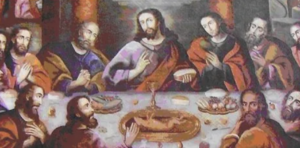
Whereas images hat depict no animal Lamb (an empty dish), but Christ holding the Eucharist are orthodox:
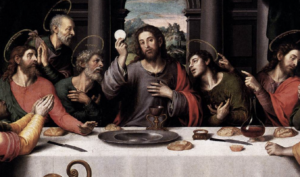
Since the Last Supper was on the anticipated evening of Nisan 14, His death happened on the same day of Nisan 14 and this unites the Eucharistic Last Supper as on the same day as the death of Christ–uniting the two events.
The Passover, then, is anytime the Eucharist is celebrated. Christ has transformed the Passover into the Eucharist. Passover is whenever the Eucharist is celebrated and is not relegated to Nisan 14/15.
– Dr. Taylor Marshall
PS: St Thomas Aquinas somehow gets all this wrong and cites Jerome, but is not aware that elsewhere Jerome affirmed that Christ died on Nisan 14. Thomas affirms that Christ died on Nisan 15:
“From which, as Jerome, says, “since the fourteenth day of the first month is called the day of the Azymes, when the lamb was slain, and when it was full moon,” it is quite clear that Christ kept the supper on the fourteenth and died on the fifteenth.” Summa Theologica, Third Part, Question 46, Article 9
Dive Deeper
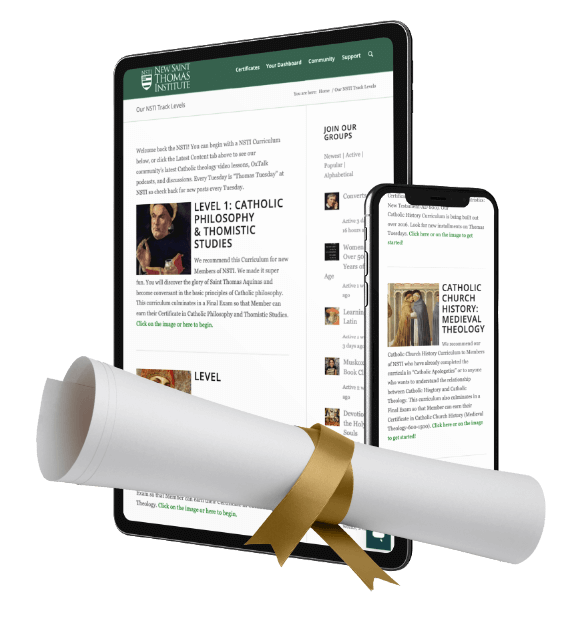
GET CONFIDENT IN YOUR FAITH
Explore the fascinating world of Catholic teachings with Dr. Marshall. Together you’ll unpack the brilliant answers the Church gives to tough questions about the Faith. The best part: you go at your own pace. Start this exciting journey today.
